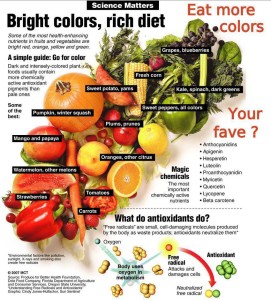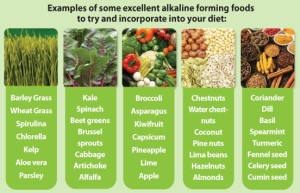 The Mama Edna Project Newsletter, June 2015, by Miranda Yerrick, Nutritionist
The Mama Edna Project Newsletter, June 2015, by Miranda Yerrick, Nutritionist
Antioxidants- What are they and how do they affect your body
Walking through the grocery store these days is basically like watching television or passing billboards. There is a constant flow of advertisements on the packaging that you may or may not even notice as you peruse the aisles. One advertisement that I seem to notice a lot is “contains antioxidants!”. So what exactly are antioxidants? Basically antioxidants are a chemical, but a chemical that is good for your body. These chemicals can be naturally occurring or man-made and they have been shown to slow or prevent damage to cells. Antioxidants need something to combat in order to be useful so that is where free radicals come into play. So what exactly are free radicals? Free radicals are kind of confusing to understand, basically they are atoms that have an uneven number of electrons. Normally a “happy” atom has an even number of electrons. These atoms can become “unhappy” when exposed to oxygen causing an uneven number of electrons. Because free radicals are missing an electron they are always looking to steal an electron from healthy atoms therefore causing a chain reaction of free radicals spreading through your body. So why are free radicals harmful? Free radicals can potentially get as crazy as to alter our DNA. DNA gets involved when a free radical is looking for an electron to steal and finds an atom to snag one from and that atom contains DNA. Once DNA atoms are being altered things get dangerous; these altered atoms can cause diseases such as cancer, Alzheimer’s, autoimmune diseases and many more.
Luckily there have been studies conducted that show increasing your consumption of antioxidants can prevent the development of free radical damage that has been associated with causing cancer.
As far as antioxidants go; they are best used as a prevention tool. Consuming foods with antioxidants while dealing with cancer and cancer treatment is completely fine to do. However, there are antioxidant supplements now which provide a large dose at one time. There have been studies done as to how this affects those during chemotherapy and radiation and the results are mixed. Some studies say it may be harmful and some say that it may be helpful. I advise speaking with your doctor if you are at all interested in antioxidant supplements. So where can you find antioxidants in order to prevent cancer and overall better your health? As with any nutrients that are good for you, think of whole naturally occurring foods! Fruits that are high in antioxidants are; blueberries, grapes, raspberries, apples, strawberries, cranberries and many more. Vegetables include; orange vegetables, sweet potatoes, beans (black eye peas, black beans, lentils, red beans), and dark green vegetables. Other sources for antioxidants include whole grains, make easy swaps such as using whole grain bread, corn tortillas instead of flour tortillas and brown rice rather than white. Tea is high in antioxidants as well, specifically green tea. Lastly, fish is also a great source of antioxidants! When shopping for fish try to look for salmon, oysters, mackerel, tuna steaks and rainbow trout.
In conclusion we should all think of antioxidants as a great thing. As mentioned in the first paragraph, the grocery store may be filled with products that promise “antioxidant power” when in reality it contains minimal ingredients that actually contain these amazing chemicals. As with anything, always stick with real whole foods! Stay away from processed foods as much as possible. Those of you that are clients of The Mama Edna Project or that just enjoy juicing should always try to incorporate antioxidant rich fruits and vegetables into your juices. Remember to always speak with your doctor if you ever consider taking an antioxidant supplement during treatment but antioxidant rich foods are absolutely fine to consume!
Here’s a great link to a blog with lots of information on antioxidants: http://ayurskin.org/antioxidants/antioxidants-good-skin/

